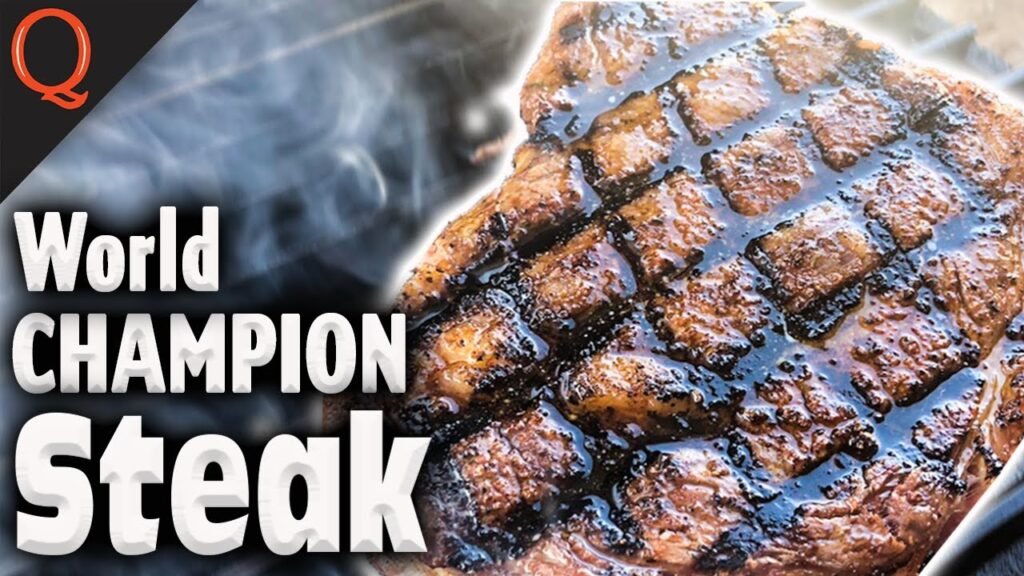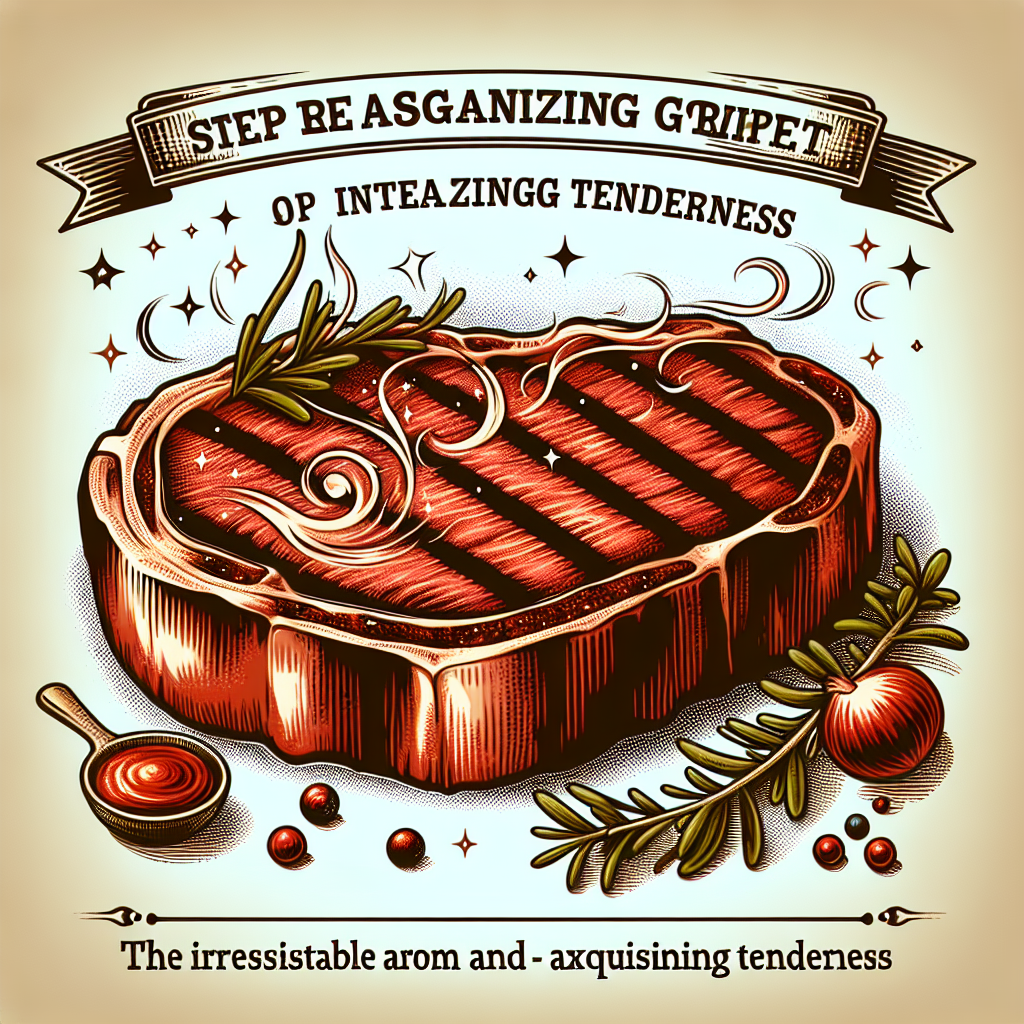Have you ever wanted to know how to cook the perfect ribeye steak? Well, you’re in luck because this article is going to show you exactly how. The techniques used by the winners of the 2015 world steak championship are revealed in this video by Kosmo’s Q BBQ & Grilling. From seasoning to prepping the cooker to cooking the steak, all the steps are laid out for you to follow along and create a mouthwatering ribeye steak. So sit back, relax, and get ready to learn the secrets of cooking a delicious ribeye steak that will impress your friends and family.
In today’s video, the host takes you through the process of cooking the perfect ribeye steak. With a touch of humor and a passion for barbecuing and grilling, he shares his tips and tricks for achieving the best results. From leaving the fat on for added flavor to using a PK grill for that extra heat, every detail is covered to ensure you have the ultimate steak experience. So grab your apron, fire up the grill, and get ready to create a mouthwatering ribeye steak that will have everyone asking for seconds.
Seasoning
Choosing the right seasoning
When it comes to seasoning your ribeye steak, the options are endless. You can choose from a variety of store-bought seasoning blends or create your own unique blend of spices. The most important thing is to choose a seasoning that complements the natural flavor of the steak and enhances its taste. Some popular seasoning options for ribeye steak include salt, pepper, garlic powder, onion powder, paprika, and dried herbs like rosemary or thyme.
Applying the seasoning
Once you have chosen your seasoning blend, it’s time to apply it to the ribeye steak. Make sure to generously coat both sides of the steak with the seasoning, ensuring that each bite is packed with flavor. Gently pat the seasoning into the steak to ensure it adheres well. It’s best to season the steak right before cooking to prevent the flavors from getting diluted or absorbed by the meat too quickly.
Allowing the seasoning to marinate
To further enhance the flavor of your ribeye steak, you can let it marinate with the seasoning for a period of time before cooking. Marinating allows the flavors to penetrate the meat, resulting in a more robust and flavorful steak. You can choose to marinate the steak for as little as 30 minutes or as long as overnight, depending on your preference. Simply place the seasoned steak in a resealable bag or a covered dish and refrigerate it until you’re ready to cook.
Prepping the Cooker
Choosing the right cooker
The type of cooker you use can greatly affect the flavor and cooking process of your ribeye steak. There are various options to choose from, including gas grills, charcoal grills, pellet grills, and even stovetop griddles. Each cooker has its own advantages and disadvantages, so it’s important to choose one that suits your cooking style and preferences. Consider factors such as heat control, convenience, and the flavor profile you want to achieve when selecting the right cooker for your ribeye steak.
Cleaning and preparing the cooker
Before you start cooking your ribeye steak, it’s essential to clean and prepare your cooker properly. Remove any leftover residue or debris from previous cookouts by scrubbing the grates or surfaces with a grill brush or scraper. Ensure that the cooker is in good working condition and all parts are properly assembled. Preheat the cooker to the desired temperature before placing the steak on the grill to ensure even cooking.

This image is property of i.ytimg.com.
Setting up the vents
For charcoal grills or smokers, setting up the vents correctly is crucial for controlling the temperature and airflow during the cooking process. The vents are responsible for regulating the amount of oxygen that reaches the coals, which in turn affects the heat intensity. To achieve a higher temperature, open the vents fully to allow more oxygen into the fire. For lower temperatures, partially close the vents to restrict airflow and reduce the heat. Adjusting the vents properly will help you achieve the ideal cooking environment for your ribeye steak.
Lighting Charcoal
Arranging the charcoal
For charcoal grills, arranging the charcoal correctly is essential to ensure even heat distribution and a consistent cooking experience. There are various methods you can use to arrange the charcoal, such as the two-zone or indirect cooking method. In the two-zone method, you create a hot zone on one side of the grill and a cooler zone on the other side by placing the charcoal unevenly. This allows for searing the steak over high heat and then moving it to the cooler side for indirect cooking. Experiment with different charcoal arrangements to find the method that works best for you.
Lighting the charcoal
To light the charcoal, you can use either a chimney starter or lighter fluid. A chimney starter is a popular method as it doesn’t require any additional chemicals and provides a consistent heat source. Simply fill the chimney starter with charcoal and place crumpled newspaper or a fire starter underneath. Light the newspaper or fire starter and let the chimney starter do its job. Once the coals are glowing red and covered in ash, carefully pour them into the grill and spread them evenly.
Ensuring even heat distribution
To ensure that your ribeye steak cooks evenly, it’s important to distribute the lit charcoal evenly across the grill. Use tongs to spread out the hot coals, creating a consistent heat source for cooking. This will prevent any hot spots on the grill and ensure that your steak cooks to perfection. Adjust the vents as needed to control the temperature and maintain even heat distribution throughout the cooking process.
Cooking the Steak #1
Preparing the grill for cooking
Before placing the ribeye steak on the grill, make sure the cooking surface is clean and properly preheated. Use a grill brush to remove any leftover debris from the grates and preheat the grill to the desired temperature. For high heat searing, aim for a temperature of around 450-500°F (230-260°C). Preheating the grill will help you achieve those beautiful grill marks and create a caramelized crust on the steak.

Placing the steak on the grill
Once the grill is preheated, it’s time to place the seasoned ribeye steak on the cooking grates. Position the steak diagonally on the grates to create those iconic crosshatch grill marks. Close the lid and let the steak cook for the desired amount of time on the first side. Avoid moving the steak too much while it’s cooking to achieve a nice sear and prevent sticking. Cooking times will vary depending on the thickness of the steak and the desired level of doneness.
Monitoring cooking time
While the ribeye steak is cooking, it’s essential to keep an eye on the cooking time to prevent overcooking. Use a timer or stopwatch to ensure that you cook the steak to your desired level of doneness. As a general guideline, for a medium-rare steak, cook it for about 4-5 minutes per side. For a medium steak, increase the cooking time to 5-6 minutes per side. Adjust the cooking time accordingly based on your personal preference and the thickness of the steak.
Cooking the Steak #2
Flipping the steak
After the first side of the ribeye steak has cooked for the desired amount of time, it’s time to flip it over to cook the other side. Use tongs or a spatula to carefully turn the steak and place it back on the grill grates. Once again, position it diagonally to create those beautiful grill marks. Avoid pressing down on the steak while it’s cooking, as this can cause the juices to escape and result in a drier steak. Allow the second side to cook for the appropriate amount of time.
Adding additional seasoning or flavor
To add extra flavor to your ribeye steak, you can consider seasoning it again or adding additional ingredients during the cooking process. As the second side of the steak cooks, you can sprinkle more seasoning or herbs on top to infuse the meat with additional flavors. Another option is to baste the steak with a marinade, butter, or herb-infused oil to create a delicious crust and enhance the overall taste. Experiment with different seasonings and flavorings to find your perfect combination.
Cooking to desired temperature
While cooking the second side of the ribeye steak, it’s important to monitor the internal temperature using a meat thermometer. This will help you achieve the desired level of doneness. For a medium-rare steak, aim for an internal temperature of around 135°F (57°C). For a medium steak, target an internal temperature of about 145°F (63°C). Remember that the steak will continue to cook slightly while resting, so it’s best to remove it from the grill when it’s a few degrees below your desired temperature.
Resting the Steaks

Why resting is important
Resting the ribeye steaks after they come off the grill is a crucial step in the cooking process. Resting allows the juices in the steak to redistribute, resulting in a more flavorful and tender final product. When the steak cooks, the heat causes the juices to move towards the center. Resting the steak allows those juices to redistribute throughout the entire cut, ensuring a juicy and delicious outcome.
How long to rest the steaks
The duration of the resting period will depend on the size and thickness of the ribeye steak. As a general rule, it’s recommended to rest the steak for about 5-10 minutes. This resting time allows the juices to settle and the steak to continue to cook slightly, helping it reach the desired level of doneness. Use this time to prepare any side dishes or garnishments that will accompany your ribeye steak.
Covering the steaks while resting
To retain heat and ensure that the steaks stay warm during the resting period, it’s best to cover them loosely with aluminum foil. This will help the steak retain its heat and prevent it from cooling too quickly. Avoid sealing the steaks tightly with foil, as this can cause them to become steamed and lose their crispy crust. By covering the steaks, you’ll also avoid any unwanted debris or insects from coming into contact with the meat.
Tasting the Steaks
Tips for tasting
Before digging into your perfectly cooked ribeye steak, there are a few things to keep in mind to fully enjoy the flavors. First, use a sharp steak knife to cut through the meat easily and ensure a clean slice. Take small, deliberate bites, allowing the flavors to linger on your palate. Pay attention to the tenderness, juiciness, and overall taste of the steak. Take note of any specific seasonings or flavorings that stand out and make the eating experience more enjoyable.
Enjoying the flavors
A well-cooked ribeye steak offers a range of flavors, from the rich and fatty marbling to the smoky and charred crust. Take the time to savor each bite, enjoying the different textures and tastes that the steak offers. The seasoned crust should provide a delightful contrast to the tender interior, creating a melt-in-your-mouth experience. Pair the steak with your favorite sides or sauces to enhance the flavors even further.
Sharing with others
Cooking a ribeye steak is a great opportunity to share a delicious meal with family and friends. Once the steaks are cooked to perfection, invite your loved ones to join you at the table for a memorable dining experience. Share your cooking techniques, seasoning choices, and the journey you took to cook these mouthwatering steaks. Eating together is not only about nourishment but also about creating lasting memories and building meaningful connections.
Cleaning the Grill
Removing residue from the grill
After you have finished cooking and enjoying your ribeye steak, it’s important to clean the grill to maintain its performance and extend its lifespan. Start by removing any leftover food particles or residue from the grates using a grill brush or scraper. Scrape vigorously to ensure that all the debris is removed, paying special attention to any stubborn, stuck-on pieces. Cleaning the grates thoroughly will prevent any unwanted flavors or odors from transferring to future meals.
Maintaining grill cleanliness
In addition to cleaning the grates, it’s essential to clean other parts of the grill to prevent grease buildup and ensure proper functioning. Remove the cooking grates and clean the areas underneath, including the heat deflectors or flavorizer bars. Use a grill brush or scraper to remove any grease or debris, and wipe the surfaces with a damp cloth. Regular maintenance will not only keep your grill clean but also improve its efficiency and performance.
Properly storing the grill
If you’re not planning to use your grill for an extended period, it’s crucial to store it properly to protect it from the elements and maintain its longevity. Make sure the grill is completely cool before covering it with a weather-resistant grill cover. Store the grill in a dry and sheltered area, such as a garage or shed, to prevent rusting and damage from rain or extreme temperatures. Regularly inspect the grill for any signs of wear or damage and address them promptly.
Tips and Tricks
Choosing the right cut of ribeye
When it comes to cooking a ribeye steak, choosing the right cut is essential for a flavorful and tender outcome. Look for ribeye cuts that have a good amount of marbling, as the fat helps to keep the steak juicy and adds flavor. Opt for USDA Prime or Choice grades for the highest quality meat. The thickness of the steak is also important, as it can affect the cooking time and level of doneness. Aim for steaks that are around 1-1.5 inches thick for the best results.
Marbling and tenderness
Marbling refers to the streaks of fat that are dispersed throughout the meat of a ribeye steak. This marbling not only adds flavor but also contributes to the tenderness of the steak. As the fat melts during the cooking process, it bastes the meat from within, resulting in a moist and tender steak. Look for steaks with even, well-distributed marbling for the best eating experience.
Enhancing flavors with butter or herbs
To take the flavors of your ribeye steak to the next level, consider using butter or herbs to add richness and complexity. Just before serving, you can top the steak with a pat of butter, allowing it to melt and coat the meat with its creamy goodness. Alternatively, you can infuse the butter with herbs like rosemary, thyme, or garlic to create a flavored compound butter that will elevate the taste of the steak. Simply mix softened butter with your desired herbs and refrigerate until ready to use.
Conclusion
Cooking a ribeye steak to perfection requires attention to detail, patience, and a few tried and true techniques. By carefully choosing the right seasoning, prepping your cooker, lighting the charcoal, and mastering the cooking process, you can create a mouthwatering ribeye steak that is tender, juicy, and bursting with flavor. Remember to rest your steaks, taste with intention, and clean your grill for optimal results. With these tips and tricks, you’ll be well on your way to becoming a ribeye steak master and impressing your family and friends with your culinary skills. So fire up that grill and get ready to savor the deliciousness that awaits!

